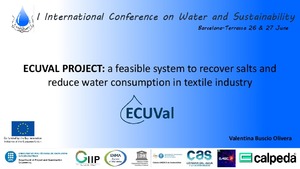Mostra el registre d'ítem simple
ECUval project: a feasible system to recover salts and reduce water consumption in textile industry
| dc.contributor.author | Gutiérrez Bouzán, María Carmen |
| dc.contributor.author | Buscio Olivera, Valentina |
| dc.contributor.author | López Grimau, Víctor |
| dc.contributor.author | Tornero García, José Antonio |
| dc.contributor.author | Gutiérrez Mérida, Mario |
| dc.date.accessioned | 2017-10-10T11:05:25Z |
| dc.date.available | 2017-10-10T11:05:25Z |
| dc.date.issued | 2017-06-27 |
| dc.identifier.citation | Gutiérrez Bouzán, M. C. [et al.]. ECUval project: a feasible system to recover salts and reduce water consumption in textile industry. A: "I International Congress on Water and Sustainability". UPC. Departament d'Enginyeria de Projectes i de la Construcció, 2017. |
| dc.identifier.uri | http://hdl.handle.net/2117/108587 |
| dc.description.abstract | ECUVal system is based on the in situ degradation of organic compounds contained in saline effluents. ECUVal achieves the partial or total degradation of organic compounds by means of an electrochemical treatment combined with ultraviolet irradiation. The removal of organic matter is carried out only by means of electricity, without the addition of chemical reagents because the salts contained in the effluents are used as an electrolyte. After the electrochemical+UV treatment, the effluent still contains all the initial salts and it can be reused in a new production process. Thus, ECUVal process enables to reduce both water and salt consumption, with the subsequent economical and environmental benefits: saving of raw materials and process water, diminution of wastewater salinity and reduction of wastewater discharge taxes. ECUVal system can be applied to remove organic compounds from any type of industrial wastewater with a high content of salts. The use of ECUVal process to treat textile wastewater is especially interesting because dyeing and washing effluents contain chemical additives and residual dyes, which cannot be easily degraded. In general, treatments based on biological processes are inefficient to remove dyes due to their low biodegradability. Physicochemical treatments such as coagulation-flocculation or membrane filtration are used with this purpose but these treatments generate a waste that requires a further treatment. In this sense, the main advantages of the ECUVal system are that no residues are generated and no chemicals are should be added. In addition, the reuse process allows saving 70-100% dyeing water and 15-60% dyeing electrolyte. |
| dc.format.extent | 6 p. |
| dc.language.iso | eng |
| dc.publisher | UPC. Departament d'Enginyeria de Projectes i de la Construcció |
| dc.rights | Attribution-NonCommercial-NoDerivs 3.0 Spain |
| dc.rights.uri | http://creativecommons.org/licenses/by-nc-nd/3.0/es/ |
| dc.subject | Àrees temàtiques de la UPC::Enginyeria tèxtil::Impacte ambiental |
| dc.subject.lcsh | Textile industry -- Environmental aspects |
| dc.subject.lcsh | Sewage -- Purification |
| dc.subject.other | electrochemical treatment |
| dc.subject.other | water reuse |
| dc.subject.other | dyes |
| dc.subject.other | textile effluents |
| dc.subject.other | salt recovery |
| dc.subject.other | salinity reduction |
| dc.title | ECUval project: a feasible system to recover salts and reduce water consumption in textile industry |
| dc.type | Conference report |
| dc.subject.lemac | Indústria tèxtil -- Aspectes ambientals |
| dc.subject.lemac | Aigües residuals -- Depuració |
| dc.rights.access | Open Access |
| local.citation.publicationName | I International Congress on Water and Sustainability |



